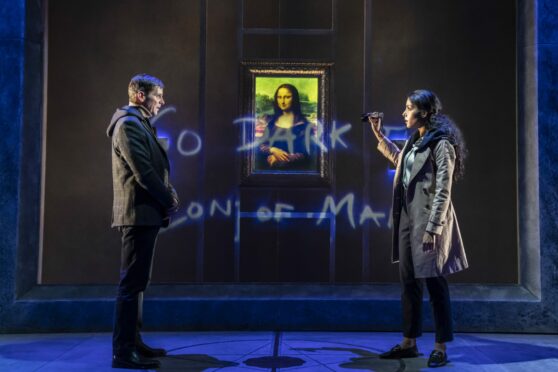
Almost 20 years have passed since the publication of one of the bestselling books of all time, The Da Vinci Code, propelled the historic Rosslyn Chapel into the mainstream.
The 15th Century building in Midlothian played a prominent part in Dan Brown’s novel and it’s been a magnet for tourists ever since.
Former EastEnders and Downton Abbey star Nigel Harman had the chance to visit recently, as he prepared to play the central role of Professor Robert Langdon in the world premiere stage version of the story, which was adapted into a film starring Tom Hanks.
“It was arresting and breathtaking to be in Rosslyn Chapel,” said Harman. “We’d been pretending to be there in the play, so to actually be there is a privilege of the job. The chapel and the Inner Temple, which also features in the play, are two of the most extraordinary buildings I’ve ever seen.”
Harman, who played Mr Green in the fourth series of Downton Abbey, stars alongside Red Dwarf actor Danny John-Jules and Hannah Rose Caton in the stage version. And he admitted that one of the ways he prepared for the role was to read the book for the first time, but in the voice of his character.
“I’m one of the few people who hadn’t read it,” he smiled. “I sat there and read it out loud to myself in an American accent, so I was learning about the more fleshed-out version of the story while practising my accent at the same time. I really enjoyed the book so it was absolutely a pleasure.
“I’d seen the film and the one thing I wanted to do was not have the mullet. That was a key character decision!
“But the stage version is very different. It moves as fast and it’s just as complex but we’ve got extraordinary visual landscapes with all sorts of projections. We’re telling the story through a visual medium and then we’ve got what I would describe as a banging soundtrack. We have this energy that is propelled throughout the play and it’s underscored so you get a real sense of time and tempo.”
While the mullet is no longer, Harman says the stage version of Langdon will be familiar to fans of the story, which sees the professor and his fellow cryptologist Sophie Neveu attempt to solve the riddles and codes left beside the murdered body of the Louvre’s curator, before a shocking secret is lost to history forever.
“He’s the Harvard professor we all know and love. He’s one of the smartest people in the room but in the play he’s also a little inept in some areas. So, he’s very human. There are moments where he’s vulnerable and at one point he loses his temper because he’s so frustrated. That’s the joy of the play – it fleshes out the main characters more than I’d say has been done before. That’s what drew me to it.”
So, too, did being involved in a world premiere production.
“It’s very exciting to be part of something new and also it means there’s work to be done,” Harman admitted. “We’re doing little re-writes and trying different things so it’s very fresh and very alive.”
As well as having a long line of theatre credits, his work in Downton, and a number of other television dramas to his name, his stint on EastEnders as Dennis Rickman from 2003 to 2005 still has people stopping him in the street.
“It’s for a range of things now but when it comes to EastEnders it depends on the length of my hair,” he added. “If my hair is cut around the same length as when I played Dennis then people get me much quicker. If it’s longer they look at me and go, ‘Do you work at the Sainsbury’s in Cheltenham?’
“EastEnders is still very much with me and it’s actually quite sweet because people light up when they talk about it or they remember a storyline and share it with me, when half the time even I can’t remember it.”
The Da Vinci Code, Theatre Royal, Glasgow, Monday-Saturday King’s Theatre, Edinburgh, April 5-9

Enjoy the convenience of having The Sunday Post delivered as a digital ePaper straight to your smartphone, tablet or computer.
Subscribe for only £5.49 a month and enjoy all the benefits of the printed paper as a digital replica.
Subscribe